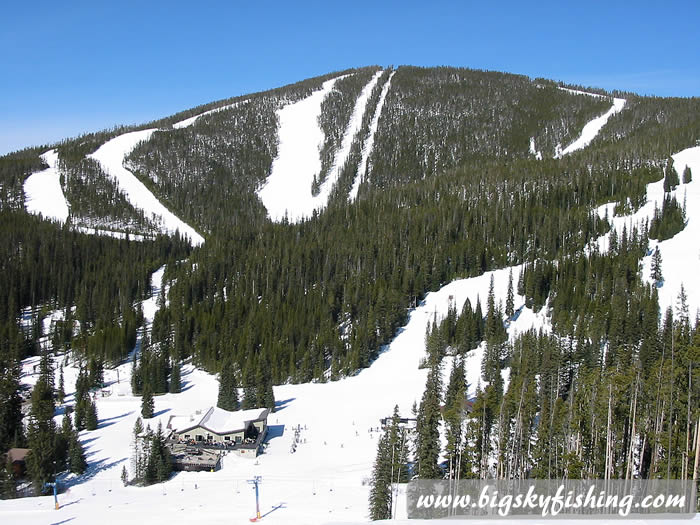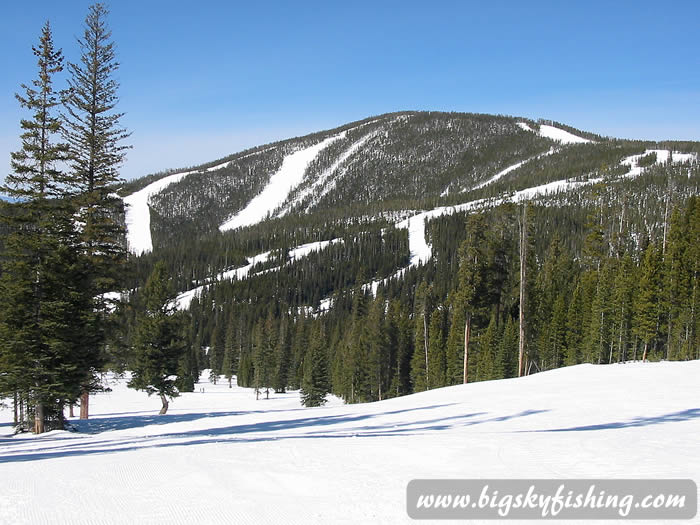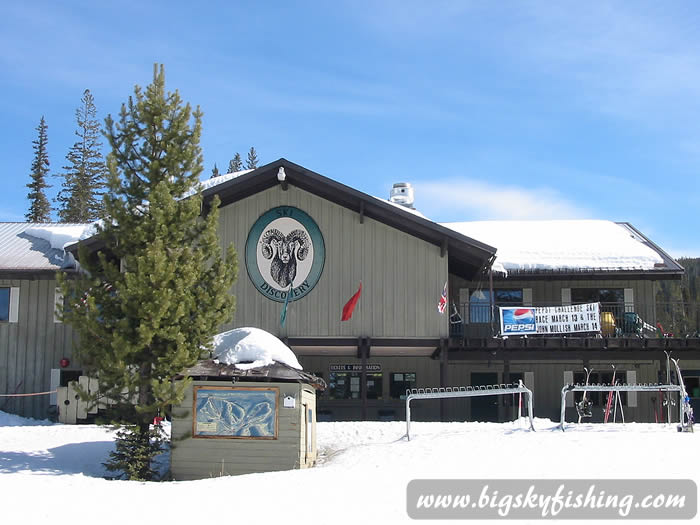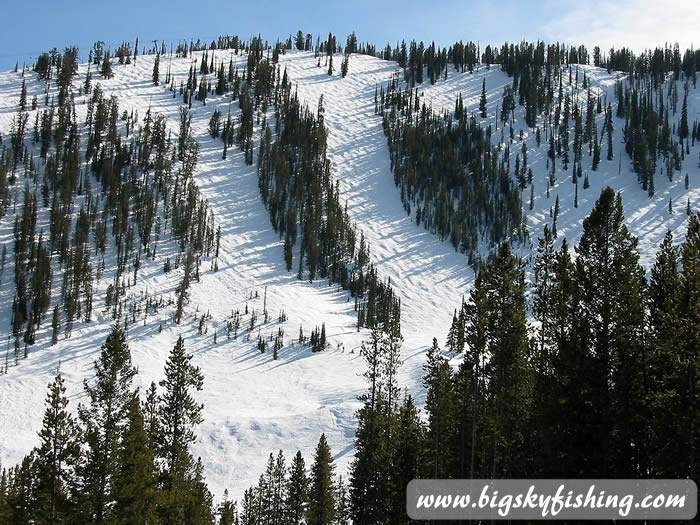Discovery Ski Area is Montana’s finest skiing secret. Lying in the heart of Montana, in a scenic and secluded setting near Georgetown Lake, Discovery Ski Area has superb skiing for all abilities. The wonderful mix of terrain at Discovery can keep anyone, regardless of skill levels, happily occupied for an entire day of skiing.
Discovery, like most other ski areas in Montana, is a ski area—not a resort. There is no slope side lodging, fancy restaurants, condos or hotels. In short, it is just a place to ski and snowboard, with the only buildings being a very nice and functional base lodge. While Discovery lacks the killer vertical and snowfall that other bigger name Montana ski areas have, it more than makes up for it with excellent terrain diversity.
Quick Links to article contents.
The Mountain
Discovery Ski Area is built on a moderate sized mountain known as Rumsey Mountain, which has a top elevation of 8150 ft. Discovery doesn’t get pounded by huge amounts of snow each year, averaging around 210 inches. However, while Discovery may not get buried under mounds of snow, the snow that it does receive tends to stick around. The high base elevation of Discovery Ski Area (6480 feet) along with its location in a known “cold pocket” of Montana inhibits melting. Additionally, as the ski area sits on the west side of the continental divide, Discovery isn’t as plagued by high winds.
 |
| Mt. Rumsey |
For those who have never heard of Discovery before, the ski area is located just off of US Highway 1 near Georgetown Lake. Although located in a very remote area, both Missoula and Butte are an easy drive away. Missoula is located 95 miles away to the west, while Butte is 45 miles to the southeast. The closest towns to Discovery Ski Area are Anaconda (25 miles to the east) and Phillipsburg (25 miles to the northwest).
Getting to Discovery Ski Area is easy. Just hop onto Highway 1 and look for the signs in Georgetown Lake. The town itself is impossible to miss since the road and town lay right along the shores of beautiful Georgetown Lake. From Georgetown Lake, just follow the signs to the ski area, which is about 5 miles from town.
While getting to Discovery is pretty simple, the roads which lead to Discovery can prove challenging at times. The road from Georgetown Lake to the ski area turns to gravel and can be a bit muddy and/or slippery at times. Secondly, US Highway 1 gains significant elevation, especially when coming from the west (Missoula and Phillipsburg). The road is generally well plowed but does have a steep gradient in places, along with many sharp turns. During snowy or slick weather, allow extra time and use caution to reach the ski area.
The Skiing At Discovery : Southern Side
The front (south) side of Discovery, which faces the base lodge, consists of trails on two mountains—Rumsey Mountain and Jubilee Peak. All beginner runs and most of the intermediate trails at Discovery are located on these two peaks. While some advanced (single black-diamond) level ski trails are found on the southern side of Rumsey Mountain, the bulk of the advanced and expert (double black-diamond) terrain is located on the north side.
The ski trails on Rumsey Mountain are accessed by the Anaconda Triple Chair, while the Jubilee Double Chair provides access to the trails on Jubilee Peak. Virtually all trails on both mountains are immaculately groomed. The trails are wide, have a nice gradient, some curves and the occasional “bump” in them.
While the southern side of Rumsey Mountain is primarily for intermediate skiers, beginners can ski from the top of Rumsey Mountain. According to the trail map, there is no beginner trails from the summit. However, don’t let the trail map fool you. The intermediate trail that leads to the “designated” beginner runs from the summit (Claimjumper) has a very gentle gradient and well-groomed. The Claimjumper Trail then turns into a designated beginner run called Red Lion, which is an excellenti trail for beginners.
Advanced skiers will find some ski trails on the front side of Rumsey Mountain. The Sluice Box Trail is a steep, usually groomed trail that closely follows the chairlift down the mountain. Another trail, Silver Bow, also has a steep gradient and is frequently bumped up as well. Still, if you like to ski the steeps, the trees or the bumps, there is much better skiing on the northern side of Discovery.
While the southern side of Rumsey Mountain primarily serves intermediate skiers, Jubilee Peak is a beginner’s playground. Technically, there are three ski trails on Jubilee Peak – one advanced, one intermediate and one beginner. However, the intermediate trail is more a “slightly steeper” beginner trail while the advanced level trail on Jubilee Peak, Northern Lights, is flat for most of its length until near its end, where the trail then takes on intermediate level gradient with some moguls.
 |
| The Gold Bug Trail |
While intermediate and advanced skiers will probably want to stay off Jubilee Peak, beginners will love it. Jubilee Peak has, in my own opinion, the finest beginner ski run found anywhere. The ski trail Gold Bug is a beautiful beginner run. The trail has a beginner level gradient and is very wide—like all beginner ski trails always are.
However, what makes Gold Bug unique is the scattering of widely spaced trees in the trail. Beginners will have a great time winding their way around these trees without having to worry about speed control (due to the flat gradient), bumps (the trail is heavily groomed) or running into a tree (the trees are very widely spaced apart).
The Skiing at Discovery : Northern Side
The northern (backside) of Discovery Ski Area contains the bulk of the advanced and expert level skiing terrain. And advanced is the apt word to use. All ski trails on the northern side of Discovery are challenging. The true “expert” level trails (the double black-diamonds) are very steep, have many bumps, cut through trees and chutes, and in general are some of the more challenging skiing terrain you’ll find in Montana. The “advanced” level ski trails (the single black-diamonds) are also very challenging. While the “advanced” ski trails have a steep gradient, they aren’t as steep as the “expert” level trails are. However, while the gradient may be a bit gentler, even on these “advanced” trails you’ll find many rocks, trees and other “obstructions” on the trail to contend with.
The backside of Discovery Ski Area consists of two sections, the East Bowl and the Granite area, each of which are serviced by their own chairlifts. The East Bowl has by far the most challenging ski terrain at Discovery, with all but two of the ski trails rated as a double black-diamond. The Granite area, by contrast, contains primarily single black-diamond ski runs with a few steep intermediate ski trails thrown in along the edges.
The East Bowl
The East Bowl is magnificent expert level ski terrain, with all trails sharing one common characteristic; they are steep. In addition to being steep, the trails cut through a wide variety of terrain. Some trails are relatively open, other trails have excellent tree skiing, and many have rocks obstructing the trails in spots.
 |
| Discovery Ski Area Lodge |
There is one single black-diamond (advanced) ski trail in the East Bowl, called Limelight, which runs below the chairlift. To be honest, the only real reason this is a single diamond instead of a double diamond is because it has a bit less of a gradient than do the other runs. However, watch out for the rocks on the lower part of this trail, especially if snow is below normal.
Beginner skiers will find no terrain for them in the East Bowl. However, there is one intermediate ski run in the East Bowl called Medicine Ridge. This ski trail is rated as an intermediate trail only because it is far simpler than the other ski runs in the East Bowl and is groomed (the only groomed trail in the East Bowl).
Medicine Ridge is very steep for an intermediate ski run. Indeed, many ski areas would classify the the trail as an “advanced” level ski run due to the gradient. Solid intermediate skiers should definitely plan on taking a run down Medicine Ridge. However, beginner or advanced beginners should "stay off" since the trail isn't a typical “intermediate ski trail” that most beginners can usually manage to ski without too many problems beyond bad form and style.
The Granite Area
The Granite area, like the East Bowl, has its own triple chair (the Granite Chairlift) and consists of intermediate ski trails on the edge with advanced level (single black-diamond) trails in the middle, with a vertical drop of 1600 feet. Since the terrain isn’t as difficult as the East Bowl, intermediate and advanced skiers should enjoy the Granite Area while being free of worries about unpleasant and inopportune injuries.
 |
| Expert Terrain |
Unlike the East Bowl, which is relatively open, the Granite area is much more wooded. The lower part of Granite is especially thick with woods. Happily, glade skiers will find some excellent terrain on the upper half of the Granite area. The woods next to the trails Granite and Center Stage have been thinned, providing nice glade skiing.
Finally, below the Granite area is some intermediate terrain served by the Silver Chief Chair. The trails here are lightly used and contain a mix of groomed cruisers and ungroomed trails with an intermediate gradient. This lower part of the Granite Area is accessed from the summit of Rumsey Mountain by using the Winning Ridge Trail.
Summary
For anyone who wants to enjoys varied terrain and wants to ski at a place that has yet to be discovered by people from out-of-state, Discovery Ski Area should be a mandatory stop. The prices are affordable, the base lodge is great, the slopes are generally un-crowded and the skiing is excellent.
When snow conditions are right, the East Bowl at Discovery provides some of the most challenging skiing terrain in Montana. The front side of Discovery, by contrast, is well groomed and contains a number of excellent intermediate and especially beginner ski runs , making Discovery Ski Area a perfect place to learn how to ski.
Mountain Stats
- Snow : 215 inches
- Vertical Feet : 2388
- Lifts : 5 triples, 2 doubles, 1 surface
- Acres : 2200
- Terrain : 20% Beginner, 25% intermediate, 55% expert.
- Nearest Towns : Philipsburg, Anaconda, Butte
